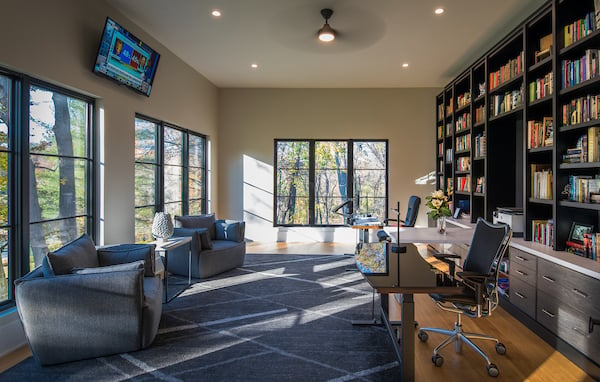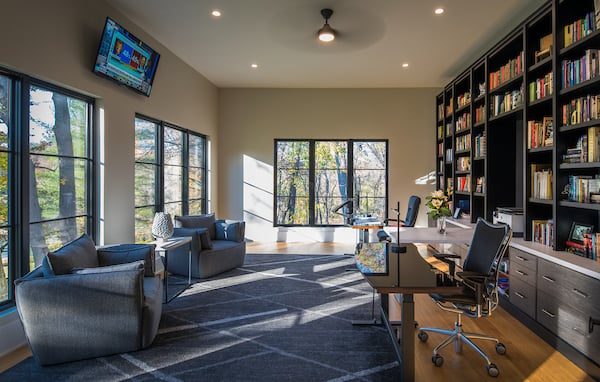Designing the Perfect Home Office: Ergonomic Solutions for Productivity
February 27th, 2024
4 min. read
By Sofia Alonso

In the era of remote work and digital entrepreneurship, the home office has transcended from a luxury to a necessity. As professionals seek to carve out dedicated workspaces within their homes, the challenge isn't just about aesthetics but about creating environments that foster productivity, comfort, and health.
At AV Architects and Builders, we leverage our decades of experience designing and building custom homes to provide you with some insight into designing an ergonomic home office that aligns with your work habits and lifestyle.
Understanding the science of ergonomics and its application can transform a mundane space into a powerhouse of efficiency and innovation. Let's explore how you can achieve this transformation, focusing on furniture, lighting, layout, and personalized design.
 AV Architects + Builders, Virginia, The Inside Out Home, Photography by Maxwell Mackenzie
AV Architects + Builders, Virginia, The Inside Out Home, Photography by Maxwell Mackenzie
The Foundation of Ergonomic Design
Ergonomics, the study of people's efficiency in their working environment, is critical in the design of a home office. It addresses how your workspace can be optimized to reduce discomfort and prevent injury, thereby enhancing productivity. The aim is to tailor the work environment to fit the individual’s needs, considering factors like posture, ease of use, and movement. An ergonomic home office design considers the physical and psychological aspects of work, promoting not just comfort but also well-being and job satisfaction. By integrating ergonomic principles, you can create a space that helps mitigate the fatigue and strain associated with long hours of work.
6 Key Components of an Ergonomic Home Office
Creating an ergonomic home office involves several pivotal components that work together to ensure comfort and efficiency. The selection of furniture plays a significant role, with chairs and desks requiring particular attention to ensure they meet ergonomic standards. Besides furniture, the arrangement of your workspace and the type of lighting used are equally important, as they contribute to your overall ability to work effectively without strain. Adequate storage solutions and clutter management also play into the ergonomic setup, ensuring that the necessary tools are within reach without overcrowding the space. Ultimately, each component should be considered in the context of the user's physical requirements and the nature of their work.
1. Ergonomic Chairs: A Must-Have
Choosing the right chair is perhaps the most crucial decision in setting up an ergonomic home office. An ideal chair supports your posture throughout the day, adapts to various body movements, and reduces the risk of back pain. Features to look for include adjustable seat height, lumbar support that matches the curve of your lower back, and flexible armrests that can accommodate different tasks. The chair should encourage dynamic sitting, allowing you to lean, stretch, and shift positions comfortably. Investing in a high-quality ergonomic chair is investing in your health and productivity.
2. Desks That Promote Well-being
The desk, like the chair, is fundamental to your home office setup. Adjustable desks, particularly those that can switch between sitting and standing positions, promote movement and flexibility throughout the day. The desk should provide ample space for your computer, documents, and any other essentials, promoting a clean and organized workspace. Consider the height and width of the desk to ensure it fits your physical dimensions and work needs, allowing for comfortable legroom and easy access to your work tools. An ergonomically designed desk can significantly contribute to your overall comfort and efficiency.
3. Natural Light and Task Lighting
Good lighting is essential for creating an effective work environment. It can enhance mood, reduce eye strain, and improve the overall ambiance of your home office. Maximizing natural light can invigorate your workspace, but it’s important to position your desk to avoid glare on your computer screen. In addition to natural light, task lighting, such as adjustable desk lamps, can illuminate specific work areas effectively. This targeted lighting should be free from distracting glares and shadows, providing a comfortable visual environment for reading, writing, and computer work.
4. Strategic Layout for Efficiency
The layout of your home office should reflect your workflow, allowing for a seamless transition between tasks. A well-thought-out arrangement minimizes physical strain by positioning frequently used items within easy reach and ensuring that your computer screen is at an optimal distance and height for viewing. Consider the flow of your work and organize your space to support these activities, whether it involves multiple monitors for trading, a large desk for drafting, or ample storage for art supplies. The goal is to create a layout that facilitates focus and minimizes unnecessary movements, making your workday smoother and more productive.
5. Incorporating Movement into Your Day
An ergonomic home office encourages regular movement to counteract the negative effects of prolonged sitting. Integrating a sit-stand desk into your workspace allows you to easily alternate between sitting and standing, promoting blood circulation and reducing muscle stiffness. Setting reminders to stand, stretch, or take a brief walk can further combat the sedentary nature of desk work. Even simple habits, like standing during phone calls or taking short breaks to do physical exercises, can have a significant impact on your health and well-being. Encouraging movement is a key aspect of ergonomic design, aiming to keep you energized and focused throughout the day.
6. Personalizing Your Space for Maximum Comfort
While ergonomic principles provide a solid foundation, personalizing your home office makes the space truly yours. Adding elements that reflect your personal style and preferences can make your office a more enjoyable and inspiring place to work. Consider incorporating artwork, plants, or a cozy reading nook to make your office uniquely yours. Personal touches not only enhance the aesthetic appeal of your office but also contribute to your overall happiness and productivity. Creating a space that feels personal and comfortable can transform your work experience, making your home office a place where you thrive.
A Holistic Approach to Home Office Design
Designing the perfect home office is a holistic process that balances ergonomic principles with personal preferences to create a space that promotes health, comfort, and productivity. By carefully selecting furniture, optimizing lighting and layout, encouraging movement, and adding personal touches, you can create an environment that supports your professional and personal well-being.
At AV Architects and Builders, we understand the importance of a well-designed home that is tailored to your lifestyle and we're here to help you create a space that not only meets your needs but also inspires your best work.
Sofia Alonso is currently the Content Manager at AV Architects + Builders, a family-owned architect-led design-build firm specializing in creating modern style homes for clients in Northern Virginia. Having been with the company since 2019, Sofia has demonstrated a strong commitment to the firm's ethos of providing high-end, luxury living experiences. Sofia holds a Bachelor of Science in Interdisciplinary Studies with a focus on Writing from the University of Virginia. With Sofia contributing to the firm's content strategy, clients can look forward to insightful, educational content that perfectly aligns with the luxurious, high-quality living experiences that AV Architects + Builders is renowned for.
Topics:




